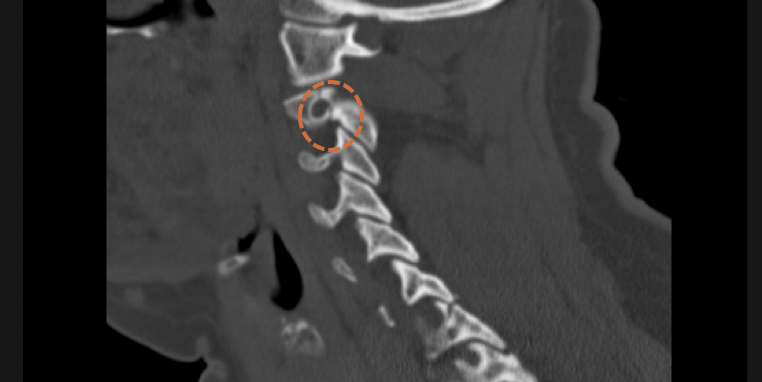
In this work, the C-Spine algorithm by Aidoc was used to investigate the effect on detection and notification time (DNT) for the detection of cervical spine fractures on non-contrast CT. A total of 2973 patients were analyzed by AI, including 2036 retrospective and 938 prospective cases. In the retrospective cohort the performance of the algorithm was analysed and a natural language processing tool was used to extract information about the presence or absence of a fracture. The median DNT was evaluated by comparing the retrospective cohort before introduction of AI to the DNT of the prospective cohort after introduction of AI. The resulting overall diagnostic accuracy was 94.8%, with a sensitivity of 89.8% and specificity of 95.3%. A time reduction of 16 minutes was found for fractured cases in the prospective cohort compared to the retrospective cohort. The study showed that the Aidoc algorithm significantly reduces turnaround time in emergency department settings and that its high diagnostic accuracy has the potential to be used as an AI-assisted workflow prioritization of cervical spine fractures on CT. However, clinically relevant cases were missed and thus there is the need for further research and comprehensive evaluation.
Read full study
Abstract
Background
Artificial intelligence (AI) applications can facilitate detection of cervical spine fractures on CT and reduce time to diagnosis by prioritizing suspected cases.
Purpose
To assess the effect on time to diagnose cervical spine fractures on CT and diagnostic accuracy of a commercially available AI application.
Materials and methods
In this study (June 2020 - March 2022) with historic controls and prospective evaluation, we evaluated regulatory-cleared AI-software to prioritize cervical spine fractures on CT. All patients underwent non-contrast CT of the cervical spine. The time between CT acquisition and the moment the scan was first opened (DNT) was compared between the retrospective and prospective cohorts. The reference standard for determining diagnostic accuracy was the radiology report created in routine clinical workflow and adjusted by a senior radiologist. Discrepant cases were reviewed and clinical relevance of missed fractures was determined.
Results
2973 (mean age, 55.4 ± 19.7 [standard deviation]; 1857 men) patients were analyzed by AI, including 2036 retrospective and 938 prospective cases. Overall prevalence of cervical spine fractures was 7.6 %. The DNT was 18 % (5 min) shorter in the prospective cohort. In scans positive for cervical spine fracture according to the reference standard, DNT was 46 % (16 min) shorter in the prospective cohort. Overall sensitivity of the AI application was 89.8 % (95 % CI: 84.2-94.0 %), specificity was 95.3 % (95 % CI: 94.2-96.2 %), and diagnostic accuracy was 94.8 % (95 % CI: 93.8-95.8 %). Negative predictive value was 99.1 % (95 % CI: 98.5-99.4 %) and positive predictive value was 63.0 % (95 % CI: 58.0-67.8 %). 22 fractures were missed by AI of which 5 required stabilizing therapy.
Conclusion
A time gain of 16 min to diagnosis for fractured cases was observed after introducing AI. Although AI-assisted workflow prioritization of cervical spine fractures on CT shows high diagnostic accuracy, clinically relevant cases were missed.